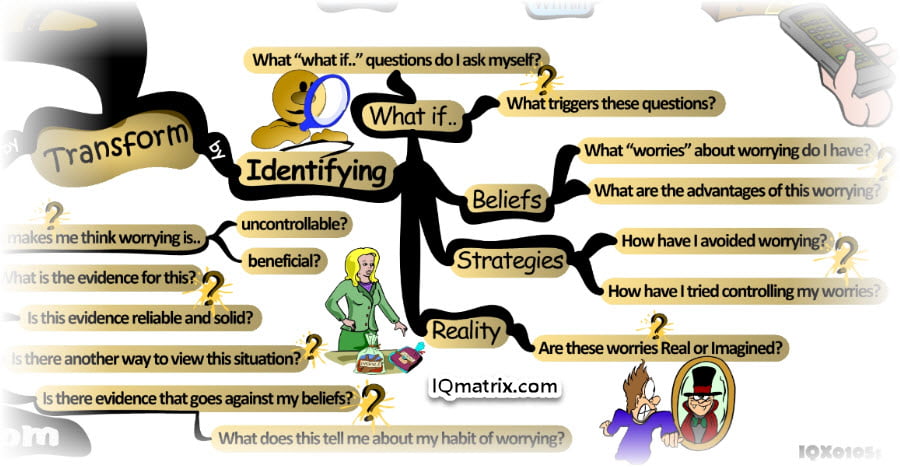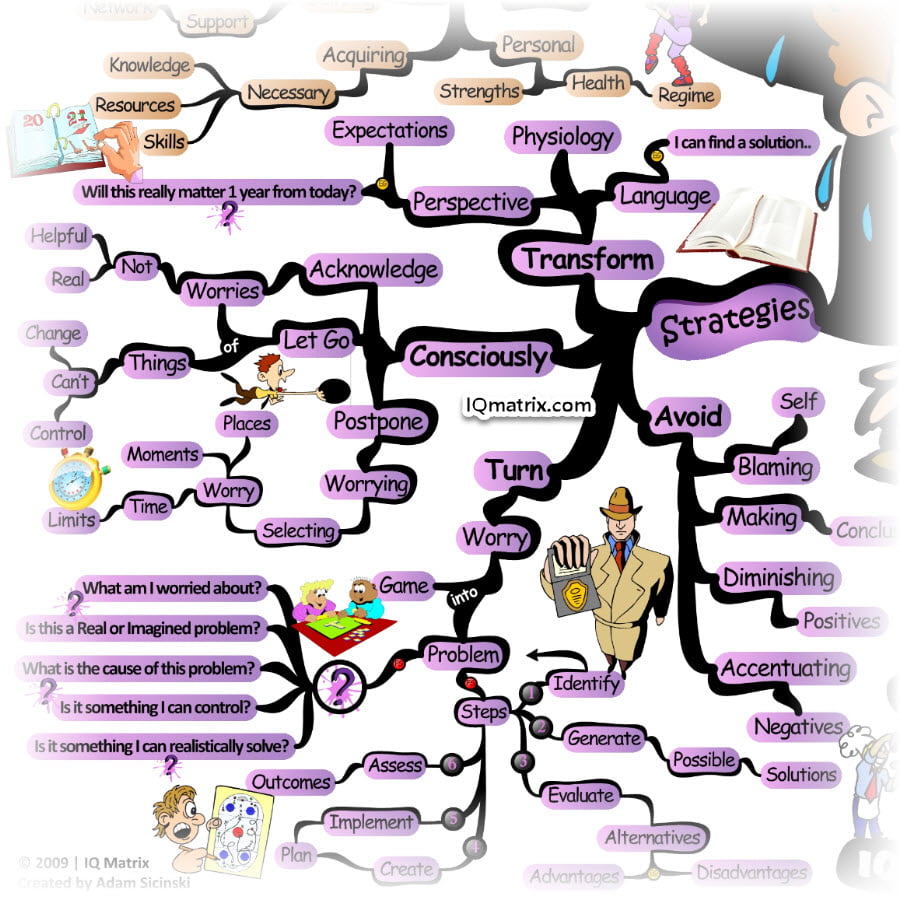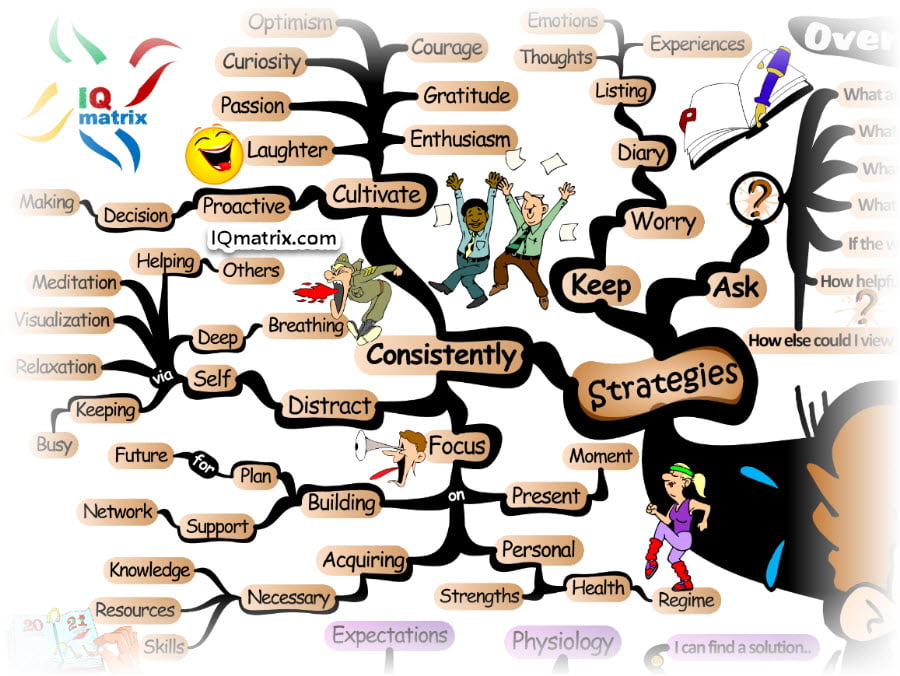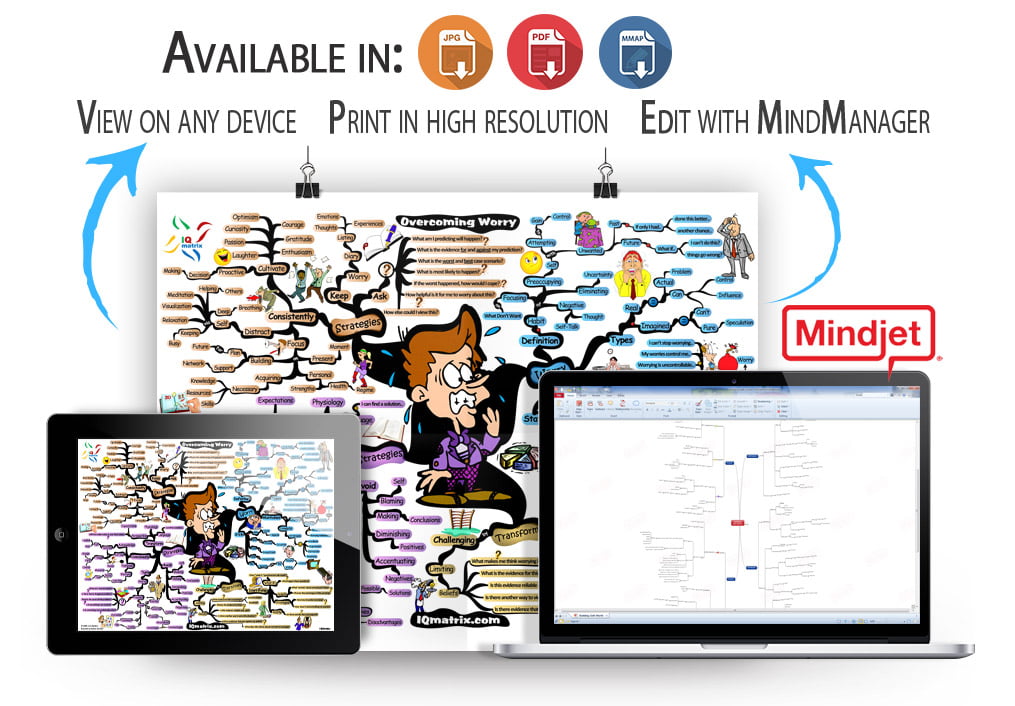If there is a solution to a problem, there is no need to worry. And if there is no solution, there is no need to worry. – Dalai Lama
Are You Feeling a Little Worried?
Are you caught up in the habit of obsessively worrying about things? Sure, it happens to all of us as we preoccupy ourselves with negative thoughts about an uncertain future. Worrying helps us gain some semblance of control over the situation. Only by controlling the situation will you be able to calm yourself down and gain some needed certainty. However, this is often flawed, because most of the things you worry about aren’t within your control, and as a result, you focus on a lot of negatives, and this makes you feel absolutely miserable.
When you worry you pose “what if” scenarios in your head about future consequences, such as:
- What if I can’t do this?
- What if things go wrong?
- What if something happened?
- What if… What if… What if…
It’s also possible to worry about past events and circumstances. There is, of course, no point in worrying about this stuff, and yet we do it anyway. For instance:
- If only I had done this better…
- If only I had another chance to rectify this situation…
- If only things were different…
- If only… if only… if only…
Worrying about the past is more about regret than it is about worry. However, it doesn’t really matter what you call it. You’re still focusing on things you don’t want, and it’s making you feel absolutely miserable.
Two Types of Worries
There are two types of worries that you probably indulge in regularly. The first is the legitimate kind of worry that presents a problem, and the second is an imagined kind of worry that creates problems.
Real Worries
The first kind of worry is the “real” kind of worry. This is the legitimate worry. Here you actually have something concrete to worry about. It could be an actual problem that you are confronting or feeling uncertain about.
These kind of worries are good because you’re working with a problem. And if you have a problem, then there’s also a solution that can be found to resolve that problem. At the very least you can probably gain some form of control or influence over this problem, which should successfully help you ease your worries.
Imagined Worries
The second type of worry is an imagined worry. These are the things you worry about that are unlikely to ever happen. They are based on pure speculation and not concrete evidence. On top of this, you have absolutely no control or influence over these matters.
You can’t resolve an imagined problem. It’s just not possible. However, you worry because you are uncertain, and because you are uncertain you tell yourself these incredible creative stories about what could potentially happen or go wrong — just to make yourself feel better.
Your worries make you feel better because you are predicting the future. This gives you a sense of certainty. And if things end up as predicted, then this will validate your feelings and make you feel somewhat in control of the situation. However, if on the other hand things don’t end up as you had predicted, then you will be relieved knowing that you actually had nothing to worry about in the first place.
There’s No Need to Worry
Do you often catch yourself worrying unnecessarily? If this sounds like you then the following stats might help validate your experiences with worry.
What if you knew that…
- 40% of your worries will never actually materialize in your life.
- 30% of your worries have already occurred and therefore there’s no point in worrying about what has already happened.
- 12% of your worries are insignificant and won’t matter a week, month and a year from now.
- 10% of your worries are unimportant. However, you blow them up in your imagination, unnecessarily giving them the spotlight in your life.
- 8% of your worries will actually become reality. However, 4% of these worries will be beyond your control.
These stats are obviously rough estimates, however, if you were to think about all your worries and kept a tab of them over the course of a year, I think you will find that these stats are pretty accurate.
The most important stat here is that only 8% of the important things you worry about will actually manifest in your life. Half of these things you will be able to control and do something about. While the other half will be out of your control. This obviously isn’t great news, however, consider that more often than not the things you worry about are almost never as bad as you imagined them to be. Who knows, you might even find the silver lining within your worries that will help you to take advantage of the situation in a positive way.
Why You Are Holding onto Worry
There are a couple of reasons why your worries are running rampant in your life. The first comes down to your belief systems, and the second is a result of a bunch of unhelpful strategies you use to cope with worry.
Limiting Beliefs
You tend to worry a lot because you give validation to a set of limiting negative beliefs you have about worrying. For instance, you believe that:
- I can’t stop worrying…
- My worries control me…
- Worrying is uncontrollable…
Here you are essentially giving up your power and all semblance of control to your worries. You feel as though they are controlling your life and that there’s nothing you can do about it. As a result, you continue to obsessively worry about things and nothing ever seems to change.
Surprisingly, you can also have unhelpful positive beliefs about worrying that also lead to the same consequences:
- Worrying prepares me…
- Worrying motivates me…
These are proactive beliefs where you feel as though you have a little more control over your worries. However, the result is still the same. You continue to worry unnecessarily and you perpetually lie to yourself that worrying is good for you, because it provides you the edge you need to get things done.
There is of course nothing wrong with reframing worry in a positive way to help you deal with the situation more effectively. However, in such instances, you’re only dealing with the symptoms and not with the cause. To eradicate worry from your life you must tackle your worries at their core, and not on the surface. Only by tackling your worries at their core will you experience lasting positive change in the long-term.
Unhelpful Coping Strategies
The second way you tend to feed your worries is by using unhelpful strategies that you feel will help you to better cope with the situation. These are your coping mechanisms for worry that you’ve picked up over time and use to help you deal with relatively uncontrollable circumstances.
You might for instance deal with your worries by avoiding them, or by suppressing them. Avoidance doesn’t solve the problem you are facing, and suppression will only make you feel more miserable and stressed in the future.
Another coping strategy that you might use is to distract yourself from your worries. This is a good short-term strategy. Maybe your distractions can help you to gain a clearer perspective of the situation. However, if you continuously distract yourself from your “real” worries, then all you’re doing is avoiding the problem, and this could potentially lead to bigger problems in the future.
The final way you might find yourself coping with worry is through reasoning. You will reason with yourself that things are okay, that everything will be alright, and that there’s no need to worry. This is a fantastic way to cope with worry, as long as you’re not ignoring the problem. Denying the fact that there isn’t a problem, isn’t going to help you to move past this worry successfully in the long-run. Sooner or later things will get worse and no amount of positive thinking will help you rectify the situation.
How to Challenge Your Worries
Before you dig into the process of overcoming your worries, it’s important that you first gain some clarity about what it is you are actually worried about and how this might be affecting your life. This clarity will help you to challenge any limiting beliefs you might have, or change the coping strategies you might currently be using.
Limiting Beliefs
Your first step is to identify the “what if” questions you tend to ask yourself about things. These are the questions that automatically trigger your worries. Ask yourself:
What “what if” questions do I tend to ask myself?
What specifically triggers these questions?
You’re worried because you are asking the wrong kinds of questions. Instead of looking for solutions to your problem, you are creating “what if” scenarios in your head about all the things that could potentially go wrong.
Take time now to identify all the “what if” questions you ask yourself. Also, pinpoint the specific events that tend to trigger these questions.
Your second step is to delve into your limiting beliefs and get a better understanding of the impact that they have on your worries. Ask yourself:
What “worries” about worrying do I have?
How are these beliefs affecting my choices and decisions?
What are the advantages of this kind of worrying?
What are the disadvantages of holding onto these beliefs in the long-term?
Worrying about something is a clear indication that you are holding onto a specific set of beliefs that are influencing how you think and respond in that particular situation. In fact, you are holding onto some of these beliefs because they are actually advantageous. They are advantageous because they provide you with a sense of control over the events and circumstances of your life. However, these beliefs often do hurt you because they don’t allow you to deal with the core reasons for your worrying — and that’s a problem.
One way to overcome your limiting beliefs about worrying is to challenge them. Here are a few examples of the questions you might want to ask yourself:
What makes me think that worrying is uncontrollable?
What makes me think that worrying is beneficial?
What is the evidence for this?
Is this evidence reliable and credible?
Is there another way I could potentially view this situation?
Is there evidence that goes against my beliefs about this?
What does all this tell me about my habit of worrying?
The more time you spend diligently questioning your limiting beliefs about worrying, the more holes you are likely to find that will help you to weaken these beliefs and therefore strengthen your commitment to proactively search for a solution to your problems.
Worries are nothing more than problems you must solve. However, you will never solve a problem if you’re caught-up uncontrollably worrying about things.
Unhelpful Coping Strategies
Now, take the time to identify some of the strategies you regularly use to cope with your worries. Ask yourself:
What strategies do I use to cope with my worries?
How do I tend to avoid my worries?
How have I tried to control my worries?
Do I tend to suppress my worries? How?
Do I tend to distract myself from my worries? In what specific way?
How do I tend to reason with my worries?
How are all these coping strategies helping me?
How are all these coping strategies hurting me?
What are some other ways I could learn to better manage my worries?
Gaining clarity about the strategies you regularly use to cope with worry will provide you with some valuable feedback that you can use to help manage your worries in the future far more effectively.
8 Things to do in the Midst of Worry
Okay, something happened and there’s a sense of uncertainty in the air. You don’t seem to have any control and you don’t know what’s going to happen next. You’re now worried and in the midst of processing all the worst-case scenarios in your head. What to do in these first few moments of worry?
There are certain things you can do the moment you are struck with worry that will help you to respond to the circumstances in more effective ways.
Acknowledge Your Worries
It’s important that you don’t resist your worries. Your worries are natural. The future is uncertain, and you have a right to concern yourself with it.
Concerning yourself about things is important and helpful. However, worrying uncontrollably about things is not at all helpful.
Take time to acknowledge how you’re feeling at the moment. This is important. However, at the same time acknowledge that worrying about things without doing anything about them is not helpful and can actually hurt you in the long-term.
Let Things Go
If you gain some control over the events and circumstances you are worried about, then that puts you in a great position to solve your problem and overcome your worries. However, at times you might not have a lot of control over people, events or circumstances. In such instances, you must let things go.
Let go emotionally of all the things you can’t change or control. These things will only weigh you down and accelerate your worries. Letting things go will provide you with greater clarity and confidence that you can get through this moment of your life successfully.
Letting things go will allow you to separate yourself from these events. Taking a step back and seeing things in a detached way could be all you need to find a better way to move forward.
Transform Your Physiology
Your physiological state is closely tied to your emotional state. This means that if you’re feeling worried, your body will likewise respond by putting you in a state of worry. Your rate of breathing will change, your muscles will tense up, and your posture will shift. This is important because it also works the other way around: Your body responds to your emotions in the same way that your emotions respond to your body.
Shift your physiology in a positive way by forcing yourself to stand up straight, to breathe deeply and to relax your muscles This will automatically send a signal to your nervous system that there is nothing to be worried about. You are now suddenly in an empowered state that will help you to get through this moment in your life far more effectively than you would in a worried state.
Shift Your Perspective
To help with your physiological transformation, take the time to talk more positively about your circumstances. Immediately look for solutions rather than focusing on what you’re worried about. Likewise, shift your expectations about the situation. Maybe things aren’t as bad as you make them out to be? Maybe you’re exaggerating your worries and there’s really nothing to be worried about? Ask yourself:
Am I seeing the full picture here?
Do I have all the information I need to view this situation clearly?
Even if things are as bad as I make them out to be, will all this really matter in 12 months time? Will it even matter next week?
It’s not so much about finding a solution at this early stage. Instead, it’s all about putting yourself in an empowered state that will help you to be more resourceful moving forward — to successfully overcome your worries.
Focus on the Present Moment
Your worries often exist in the future. However, your solutions and opportunities can only be found in the present moment. For this very reason, it’s absolutely paramount that you become mindful of the present moment and focus on what you can do right now to alleviate your worries.
Distract Yourself
When worry strikes, it’s easy to become quickly overwhelmed with this emotion. This is especially true if you feel absolutely powerless to do anything about your worries. If that sounds like you, then you might need to use a little distraction to take your mind off things.
It’s important though that you distract yourself in the right way. Distracting yourself with addictions such as alcohol, overeating, and mindless television watching is never helpful. Avoid these addictions at all costs. Instead distract yourself by temporarily keeping busy with work, by taking a nap, by relaxing in the sun, by meditating, exercising and/or visualizing a perfect solution to your worries. All of these distractions will help by giving you time to be alone with your thoughts without negative consequences.
Another positive way you could distract yourself is by helping other people with something. This will not only take your mind off things but may also provide you with an opportunity to talk with the other person about your worries. Who knows they may even provide you with the nugget of gold you are searching for that will help you alleviate all your worries.
Keep in mind that these are only temporary solutions that might be able to provide you with a little more space to think and plan a better way forward. It’s fine to do this in the short-term, however, this is not a great long-term strategy because you are essentially distracting yourself from your problems. Problems don’t disappear through distraction. They disappear when you figure out how to solve them. Therefore only use distractions as a short-term band-aid to help you calm down and clarify your path moving forward
Avoid Thinking Traps
When in the midst of worrying avoid blaming yourself for what you did or failed to do. Blame isn’t going to get you anywhere. It will just make you feel sorry for yourself and even more miserable.
Avoid making conclusions or assumptions about how things are or how they should be. Instead, think intelligently about the situation and draw conclusions based on facts, not assumptions.
Finally, avoid accentuating the negatives by blowing things out of proportion and making the situation far worse than it is. At the same time avoid diminishing the positives. No matter how concerning the circumstances, there must be some positives you can take from this situation.
Cultivate Positive Qualities
There are certain qualities you can begin cultivating immediately that will take your mind off your worries. For instance, gratitude will help you to come to appreciate what you currently have instead of what you could potentially lose. Optimism will help you to stay focused on finding solutions. Laughter will make you feel better and may even help you to think more clearly about your worries. Courage will help you to be more decisive to take the necessary steps to resolve whatever it is you’re worried about. And curiosity will encourage you to ask the right kinds of questions that might help you to find a better path moving forward.
Take time to cultivate as many of these positive qualities during times of worry, and you will find that you instantly become more resourceful and happy. Worrying will become an afterthought as you begin taking proactive action to resolve your situation.
Ideas on How to Overcome Your Worries
There are a wide variety of things you can begin doing today that will help you to overcome your worries in the long-term. Some of these strategies are simple and straightforward, while others require a little imagination and initiative. What’s most important is that you experiment and try out a few things to get a better feel of how they could potentially help you overcome your worries. Start slow and build momentum over time. You’ll eventually get really good at this stuff, and at that stage, hopefully worrying will no longer be a part of your vocabulary.
Turn Worry into a Problem or Game
The moment you begin worrying about something, realize that you have a real problem on your hands. And if for some reason it’s not a problem, then it’s not real, and you, therefore, shouldn’t be worrying about it anyways. Your imagination is playing tricks on you and creating an imagined reality that is taking over your emotional experience. Let this go. Focus instead on what is real and tangible. Solve a problem!
Before you begin solving a problem, you must figure out what you’re working with and whether it’s worthwhile pursuing a solution. Ask yourself:
What am I worried about?
Is this a real or imagined problem?
What is the cause of this problem?
Is it something I can control and influence?
Is this problem something I can realistically solve?
If after going through these questions you’ve come to the conclusion that you are dealing with a real problem that you can realistically solve, then take the time to move through a simple six-step problem-solving process:
- Identify the problem you are facing (you already did this above).
- Generate and brainstorm possible solutions to this problem.
- Evaluate the advantages and disadvantages of the solutions and pick the best one moving forward.
- Create a plan of action to implement the best solution.
- Take action to implement your plan to resolve this problem.
- Assess the outcome and learn from your experience to make necessary improvements for the future.
This is a very simplified version of the problem-solving process, however, it should provide you with enough of a platform that will help you to put a plan of action together to overcome your worries successfully.
If for instance, you don’t like solving problems, then reframe what you’re worrying about and turn it into a game. You’re no longer dealing with a problem but rather playing a game. Your objective is to first learn the rules of this game, and then play to win. Winning the game will help you solve the problem and overcome your worries. Game over!
Lay Down a Path Moving Forward
Questions are the key to greater insights and clarity. Use questions to help you better understand your situation and to also build a platform to help you move forward beyond this worried state. Ask yourself:
What am I predicting will happen?
What is the evidence for and against my prediction?
What is the worst and best case scenario?
What is most likely to happen?
If the worst happened, how would I cope with it?
How helpful is it for me to worry about this?
How else could I view this situation?
Answering these questions will hopefully help you to see the situation you are worried about as it really is and not something that you imagine it to be. They will also help you to put things into better perspective and allow you to make better and more educated decisions moving forward to help resolve your worries.
Keep a Journal
Sometimes the best way to get over your worries is to write about them in a journal.
The act of writing down your thoughts and experiences will help you to get your worries out of your head and down on paper. Once on paper, you might see them in a clearer light. They will no longer be imaginings in your head, but will rather become real and tangible on paper. With greater clarity will come greater insight. You might even realize that what you have been worrying about makes absolutely no sense at all once it’s all laid out on paper in front of you.
Look After Your Health
The people who are most capable handling overwhelming emotions such as worry are the people who are the most health conscious. They are the people who take the time to eat the right things, to drink enough water and get the proper amount of exercise, sleep and rest throughout the week. It’s all a balancing act, and your health is your number one priority.
Develop Your Coping Skills
Are you able to handle and manage stress, frustration, fear, overwhelm, anxiety, worry and a plethora of other emotions? If not, then you need to acquire the necessary skills to manage these emotions on a daily basis. At the very least learn more about each of these emotions or speak with other people to find out how they handle their emotions throughout the day. The insights and knowledge you gain can do wonders for your long-term emotional well-being.
Build a Support Network
Your support network is made up of people who can be there for you when you need them most. These are the people who will help ease your worries while providing you with a shoulder to lean on and someone to talk to at your greatest time of need.
Your support network could include family members, friends or colleagues. It could even be an online support network or a community meet-up group. No matter what it is, or where it is, it’s important that you always have people you can talk to during times of greatest uncertainty and worry.
Postpone Your Worrying
If all else fails, and you just can’t help yourself but worry about things, then at least don’t allow your worries to affect other people or other areas of your life.
In such instances take out your calendar and pick a time, a place, and a date that you allocate for all your worrying. Yes, actually schedule a time in your diary for worrying. However, make sure that you schedule it as an appointment with yourself that has a start and end time.
Once the appointment is over and done with, just move on with your life and forget about those worries. Hopefully, by that stage, you will have gotten over things and worrying becomes a non-issue. However, if you’re still hung-up about worrying, then make yet another appointment with yourself to do more worrying at a future date and time. As long as you keep your worries from affecting other areas of your life, then you are successfully minimizing the harm and the impact your worries could have on your future decisions and actions.
Time to Assimilate these Concepts
Did you gain value from this article? Is it important that you know and understand this topic? Would you like to optimize how you think about this topic? Would you like a method for applying these ideas to your life?
If you answered yes to any of these questions, then I’m confident you will gain tremendous value from using the accompanying IQ Matrix for coaching or self-coaching purposes. This mind map provides you with a quick visual overview of the article you just read. The branches, interlinking ideas, and images model how the brain thinks and processes information. It’s kind of like implanting a thought into your brain – an upgrade of sorts that optimizes how you think about these concepts and ideas. 🙂
Recommended IQ Matrix Bundles
If you’re intrigued by the idea of using mind maps for self-improvement then I would like to invite you to become an IQ Matrix Member.
If you’re new to mind mapping or just want to check things out, then register for the Free 12 Month Membership Program. There you will gain access to over 90 mind maps, visual tools, and resources valued at over $500.
If, on the other hand, you want access to an ever-growing library of 100s of visual tools and resources, then check out our Premium Membership Packages. These packages provide you with the ultimate visual reference library for all your personal development needs.
Gain More Knowledge…
Here are some additional links and resources that will help you learn more about this topic:
- 3 Tips for Overcoming Your Worried Brain @ Success
- 5 Tips to Avoid Becoming a Chronic Worrier @ Psychology Today
- 6 Signs You Worry Too Much About What Others Think @ Huffington Post
- 7 Things to Stop Worrying About Today @ Marc and Angel Hack Life
- 9 Scientifically-Backed Ways to Stop Worrying @ Huffington Post
- 10 Hacks to Help You Stop Worrying Now @ Lifehack
- Don’t Worry, Be Happy @ Psychology Today
- How Can I Stop Worrying About Things I Cannot Control? @ Personal Excellence
- How to Stop Worrying About Worrying @ World of Psychology
- How to Turn Worry into an Ally @ Pick the Brain
- The End of Worry @ Think Simple Now










